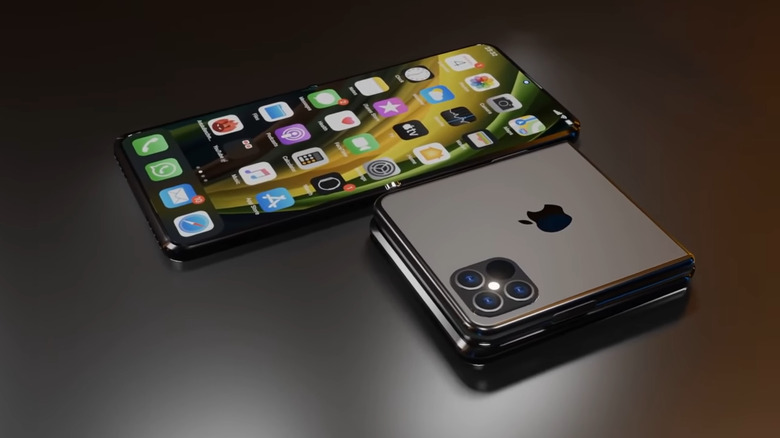Apple's Foldable iPhone Release Date Was Just Leaked By A Top Insider
Foldable phones are about to get more durable and affordable than before, as more smartphone vendors are interested in the new form factor. Samsung's upcoming Galaxy Z Fold 3 and Z Flip 3 are expected to deliver several upgrades to improve durability, including stronger foldable glass, water and dust resistance rating, and other design improvements to prevent accidental damage. Handset vendors from China will launch cheaper foldables than Samsung, lowering the entry price significantly — Samsung has started cutting the prices of its current foldable versions as well.
Apple is nowhere near ready to launch a foldable iPhone. But the company is working on such iPhone designs. A reliable leaker that said in the past that Apple is interested in making foldable iPhones now has a tentative release date in mind for the first foldable iPhone, complete with specific design details about the handset.
Analyst Ming-Chi Kuo says the first-gen foldable iPhone will launch in 2023, featuring an 8-inch foldable OLED display with QHD+ resolution. According to a new research note that MacRumors saw, Apple might sell as many as 20 million units in 2023. That figure would far exceed current foldable sales — from Kuo's report:
Based on our latest industry survey, we forecast that Apple will likely launch a foldable iPhone with an 8-inch QHD+ flexible OLED display in 2023, with SDC as the exclusive display supplier and Samsung Foundry as the exclusive DDI foundry provider. Based on Apple's requested capacity plan, we predict that the foldable iPhone shipments will reach 15-20 million units in 2023. We expect that the foldable iPhone will adopt TPK's silver nanowire touch solution because of its several advantages over SDC's Y-Octa technology.
The insider says that foldable phones will become a "must-have" design for all major smartphone makers and boost the next "super replacement cycle" for high-end handsets. He sees Apple as the "biggest winner" in the foldable market, despite coming late to the party:
At present, the product position of foldable smartphones is mainly to integrate the smartphone and tablet. But we believe that the foldable smartphone is only one of the applications of the foldable design. We predict that foldable devices will blur the product segmentations between smartphones, tablets, and laptops in the future. With its cross-product ecosystems and hardware design advantages, Apple will be the biggest winner in the new foldable device trend.
Samsung's first foldable phone launched in 2019, and the company has big plans for its foldable phones. Samsung wants to replace the Note series with foldable handsets like the Fold and Flip this year. This could help the company increase revenue, as foldable are more expensive than traditional handsets.
Kuo also offered specific details about the new foldable OLED screen that will go into the iPhone. Apple will reportedly adopt a silver nanowire touch solution that will better serve foldable devices that might support more than a single fold.
Future foldable devices will require touch technology that supports multiple folds (vs. only a single fold in current foldable smartphones), rollable, medium to large size display, and durability. When comparing the advantages of the above specifications, the silver nanowire is similar or superior to SDC's Y-Octa.
Kuo believes nanowire touch technology will give Apple a "long-term competitive advantage" for Apple. He said that Apple is already using it for the touch interface of the HomePod. This initiative allows Apple to "master the technology" at a lower cost, using small volume production.
The analyst also said a few weeks ago that some of the 2023 iPhones will have a perfect display design. The notch will disappear as the Face ID components will be placed under the display. Those claims did not mention foldable screen designs, however. It's likely Apple will use under-display camera and Face ID tech for all iPhone flagships once it meets its quality standards, and this rumored 8-inch foldable iPhone will surely be a flagship handset.
